Knife sharpening is a cornerstone of knife care, ensuring optimal performance and longevity. This guide covers essential tools, techniques, and tips for mastering the art of sharpening, helping you achieve razor-sharp edges with ease and precision.
Why Knife Sharpening is Important
Knife sharpening is crucial for maintaining blade performance, safety, and longevity. A dull knife requires more force, increasing the risk of accidents and making tasks less efficient. Regular sharpening ensures precise cuts, reduces wear and tear, and extends the life of the knife. Sharp knives are essential for professional chefs and home cooks alike, as they enhance productivity and result in cleaner, more accurate work. Neglecting sharpening can lead to damaged edges and a shorter blade lifespan. By prioritizing sharpening, you preserve your investment in quality knives and maintain their effectiveness for years to come.
Basic Principles of Knife Sharpening
Knife sharpening revolves around understanding the optimal angle, maintaining consistency, and using the right tools. The process begins with identifying the “sweet spot,” where the blade aligns perfectly with the sharpening surface. Using the entire length of the whetstone ensures even wear and a uniform edge. Sharpening jigs and steels help maintain precise angles, while slow, steady strokes refine the blade. Patience is key, as rushing can damage the knife. Regular maintenance, including honing and stropping, preserves sharpness and extends the knife’s life. Mastery of these principles ensures a razor-sharp edge, enhancing both safety and cutting efficiency for any task.
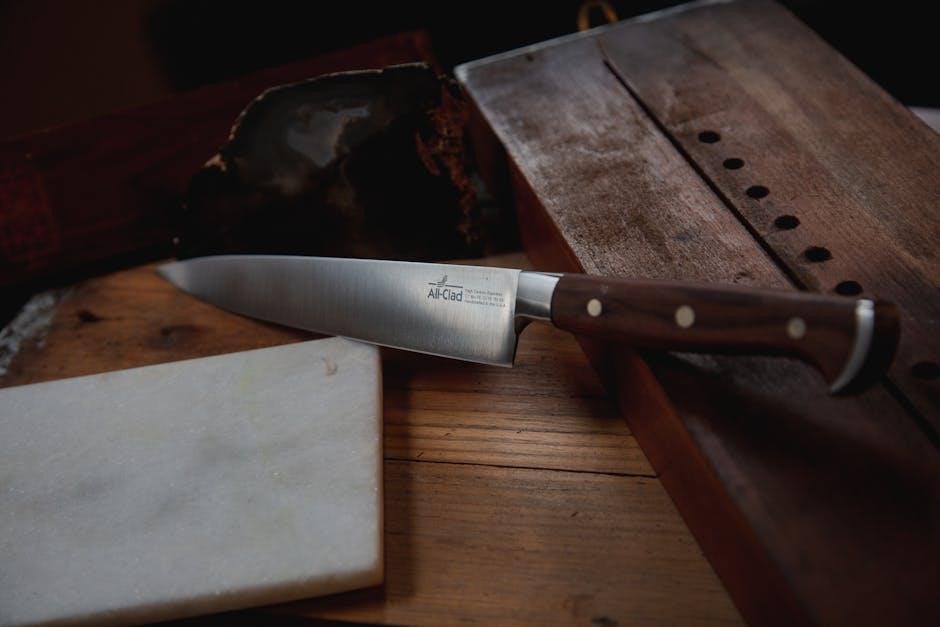
Essential Tools for Knife Sharpening
Whetstones, sharpening steels, and jigs are vital for achieving sharp edges. These tools, along with cleaning cloths and angle guides, ensure precise sharpening and maintenance of knife performance.
Whetstones: Grits and Types
Whetstones are fundamental for knife sharpening, available in various grits and materials. Coarse grits (300-1000) remove metal quickly, while finer grits (3000-8000) polish the edge. Arkansas stones are oil-based, known for durability, while Japanese water stones use water and offer exceptional sharpening ability. Ceramic stones combine durability with versatility. The choice of stone depends on the knife type, desired sharpness, and personal preference. Using lower grits first prepares the blade, and higher grits refine the edge. Proper stone maintenance ensures even wear and consistent results. Always use the entire stone length for uniform sharpening, as uneven wear can reduce effectiveness over time.
Sharpening Steels: Their Role in Maintenance
Sharpening steels, or honing steels, play a crucial role in maintaining knife sharpness between sharpenings. They realign the blade’s edge, correcting minor dulling without removing metal. Used regularly, steels extend the knife’s sharpness. Steels come in various materials like stainless steel, ceramic, and diamond-coated. The process involves drawing the knife along the steel at the correct angle. For straight-edge knives, a smooth, consistent stroke is optimal. For serrated blades, a gentle, back-and-forth motion is recommended. Proper technique ensures the edge remains aligned and sharp. Regular honing prevents the need for frequent sharpening, preserving the knife’s longevity and performance. Steels are essential for chefs and home cooks alike.
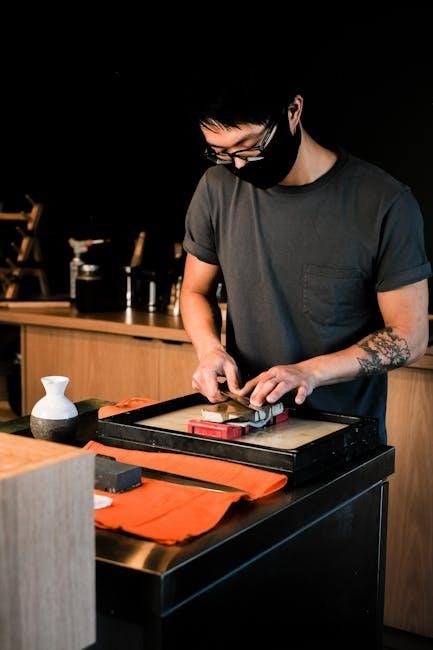
Sharpening Jigs: How They Help Maintain Angles
Sharpening jigs are tools designed to hold the knife at a precise angle during sharpening, ensuring consistency and precision. They are especially useful for beginners, as they eliminate the difficulty of maintaining the correct angle manually. By clamping the blade in place, the jig guides the sharpening stone or steel along the edge, preventing uneven wear. Advanced models allow for angle adjustments, catering to different knife types. Tools like the Razor Edge guide or Lansky Quad-Sharp are popular choices, offering repeatable results. Sharpening jigs simplify the process, making it easier to achieve professional-level sharpness and maintain blade integrity over time.
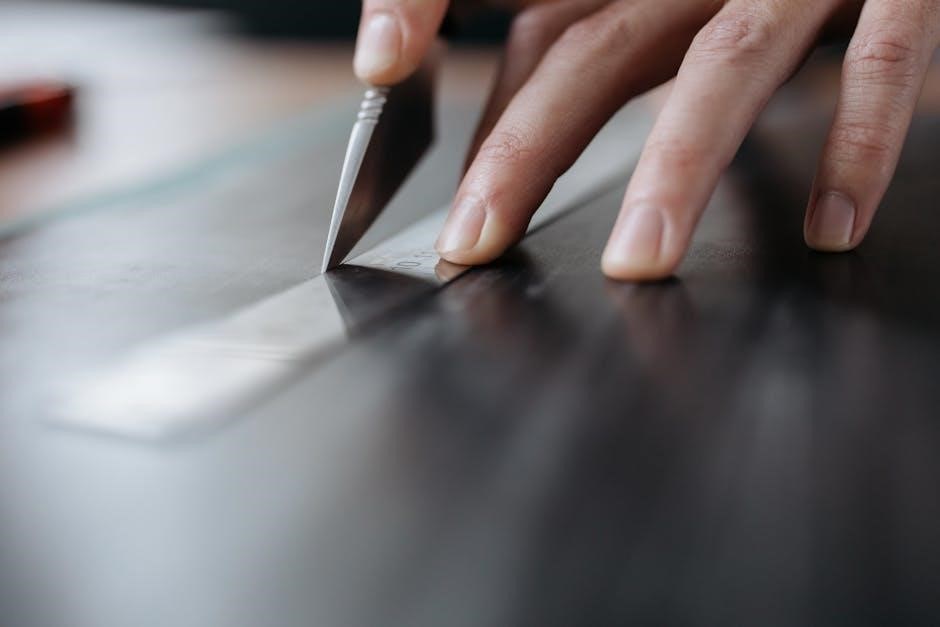
Understanding the Sharpening Angle
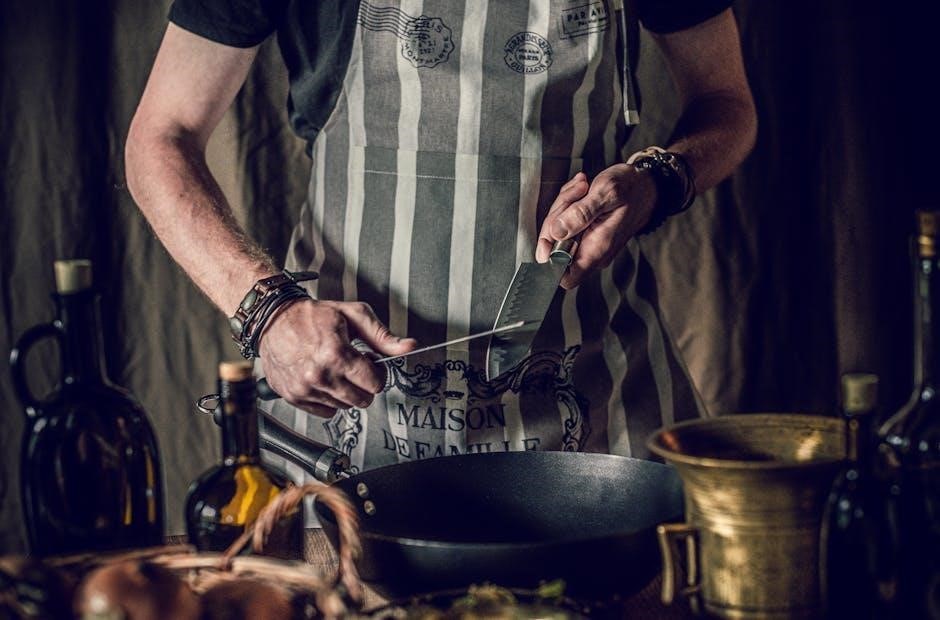
The sharpening angle is crucial for achieving a sharp edge, varying by knife type. Finding the “sweet spot” ensures consistency, while maintaining it prevents uneven wear and enhances performance.
Optimal Angles for Different Knives
Different knives require specific sharpening angles for peak performance. Chef knives typically use a 20-degree angle, while pocket knives may need 30 degrees. Thicker blades, like cleavers, benefit from a shallower angle, around 25 degrees, to maintain durability. Japanese knives often use a more acute 15-degree angle for precision cutting. The angle is determined by the knife’s intended use and steel type. Using the wrong angle can lead to dulling or uneven edges. Always consider the knife’s purpose and manufacturer recommendations when setting the angle. Proper alignment ensures a sharp, long-lasting edge tailored to the knife’s function. Consistency is key for optimal results.
How to Find the Sweet Spot for Consistent Sharpening
Finding the sweet spot for consistent sharpening involves identifying the optimal point where the blade meets the stone. Start by holding the knife at the desired angle and lightly drawing it across the stone. Pay attention to the area where the edge consistently makes contact. Mark this spot with a marker for reference. Use a sharpening jig or guide to maintain precise alignment. Practice slow, steady strokes, ensuring even pressure across the blade’s length. Over time, muscle memory will help you locate this sweet spot instinctively, leading to consistent and precise sharpening results every time. Patience and practice are essential for mastery.
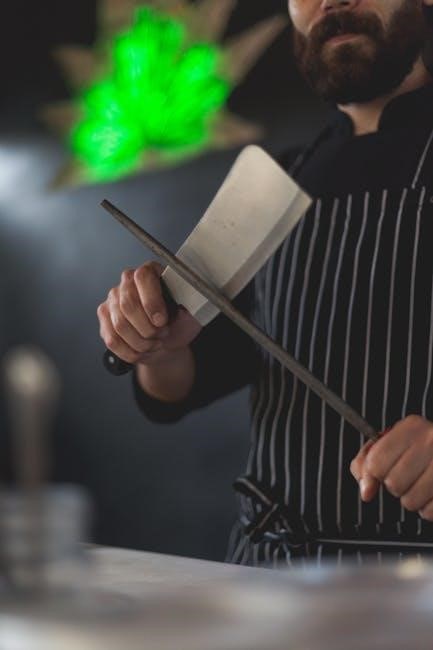

Preparing the Knife for Sharpening
Before sharpening, inspect the blade for damage and establish a starting bevel. Clean and secure the knife, ensuring a stable surface for consistent sharpening results and safety.
Inspecting the Blade for Damage
Inspecting the blade for damage is crucial before sharpening. Look for chips, cracks, or rust, which can affect sharpening efficiency. Use a magnifying glass to spot micro-chips or uneven edges. Check for straightness by sighting along the edge. If damage is severe, professional repair may be needed. Cleaning the blade with a soft cloth removes debris, ensuring a clear view. Identifying these issues early prevents further damage during sharpening. A damaged blade may require specialized techniques or tools to restore its edge safely and effectively. Always handle the knife with care to avoid accidents during inspection.
Setting the Initial Bevel
Setting the initial bevel is a critical step in knife sharpening, as it establishes the foundation for achieving a sharp edge. Begin by marking the bevel with a marker to visualize the edge. Position the knife on the whetstone at the desired angle, using light pressure to draw the blade across the stone. Repeat this process, maintaining consistent angle and pressure to avoid mistakes. Check the bevel regularly to ensure it is forming evenly. Once the marker line is worn away, the initial bevel is set. This step ensures proper alignment and prepares the blade for further sharpening. Consistency is key to achieving a razor-sharp edge.
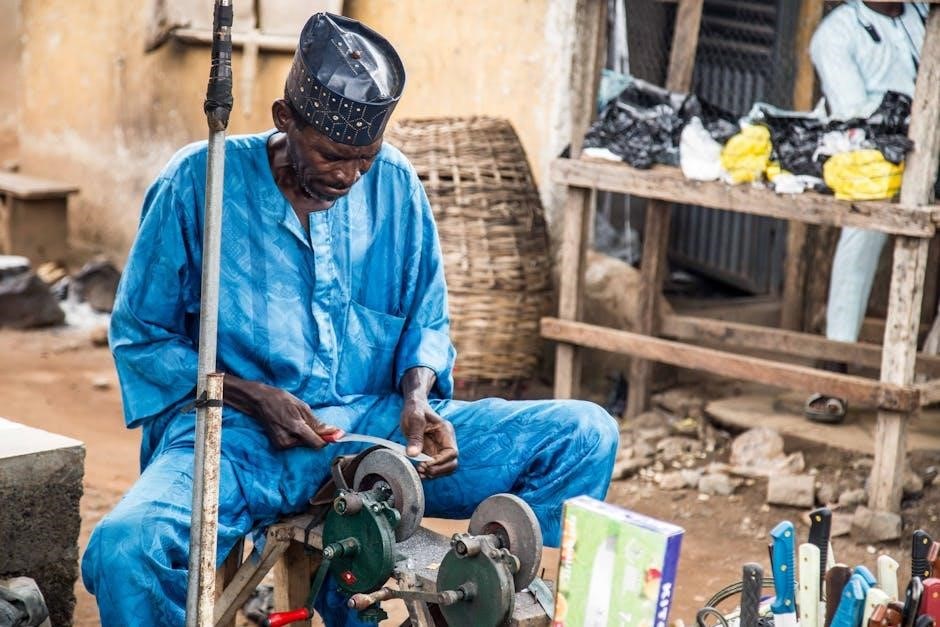
The Sharpening Process
The sharpening process involves progressively refining the knife’s edge using whetstones or steels. Start with coarse grits to establish the edge, then transition to finer grits for polishing, ensuring precision and consistency throughout.
Step-by-Step Guide to Using a Whetstone
Using a whetstone effectively requires patience and technique. Start by soaking the stone in water for 10-15 minutes. Place the knife at the desired angle, using the entire stone length for even wear. Slowly draw the blade across the stone, moving from heel to tip, maintaining consistent pressure. Repeat on the other side, flipping the knife carefully. After several strokes, inspect the edge for sharpness. If needed, progress to finer grits for polishing. Finally, hone the knife with a sharpening steel to align the edge. This method ensures a razor-sharp finish, enhancing the knife’s performance and longevity.
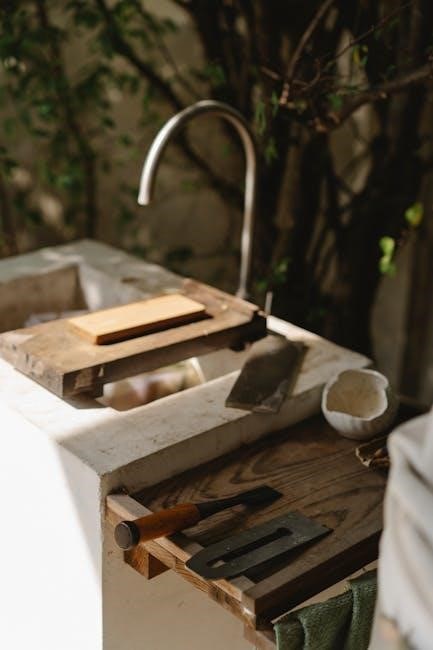
How to Use a Sharpening Steel Effectively
Using a sharpening steel is essential for maintaining a knife’s edge. Hold the steel vertically on a stable surface, gripping it firmly. Place the knife at the desired angle, typically between 20-30 degrees, and draw it down the steel in a smooth, consistent motion. Start at the heel and move toward the tip, repeating on both sides. Light pressure is sufficient; excessive force can damage the edge. After several strokes, inspect the knife for sharpness. For best results, hone the knife after each use and before storage. Regular honing prevents the edge from dulling and extends the knife’s lifespan.
Sharpening with a Jig: Precision and Consistency
A sharpening jig is a tool designed to hold the knife at a precise angle, ensuring consistency during the sharpening process. It is particularly useful for beginners, as it simplifies maintaining the correct angle. To use a jig, clamp the knife securely and adjust the angle setting. Draw the knife across the stone or steel in smooth, controlled strokes, using the jig to guide the blade. This method prevents uneven sharpening and ensures the edge remains consistent. Regular use of a jig helps maintain precision, making it easier to achieve professional-level results; It is an invaluable tool for anyone seeking consistent, high-quality sharpness.

Maintenance and Care After Sharpening
Proper maintenance involves honing and stropping to preserve sharpness. Store knives in dry places, away from other utensils, to prevent dulling and damage. Regular care extends longevity.
Honing and Stropping for Longevity
Honing and stropping are crucial for maintaining knife sharpness. Honing involves using a sharpening steel to align the blade’s edge, ensuring straight cuts. Stropping, typically done on leather or canvas, polishes the edge, removing micro-scratches. These techniques prevent dulling and extend the knife’s life. Regular honing maintains sharpness between sharpening sessions, while stropping enhances edge refinement. Together, they ensure peak performance and longevity. Consistent practice of these methods keeps knives in optimal condition, making them reliable for years. Proper technique is key to maximizing effectiveness. These steps are essential for any knife owner seeking durability and sustained sharpness.
Storage Tips to Preserve Sharpness
Proper storage is vital to maintaining a knife’s sharpness. Store knives in a dry, cool place, away from direct sunlight. Avoid stacking knives, as this can cause nicks or dulling. Use a protective edge guard or sheath to prevent accidental damage. For multiple knives, consider a blade case or magnetic strip with spacing to prevent contact. Clean and dry the knife thoroughly before storage to prevent rust or corrosion. Avoid storing knives in humid environments or near chemicals. Regularly inspect stored knives to ensure they remain sharp and undamaged. Proper storage extends the life of your knife and keeps it ready for use when needed.